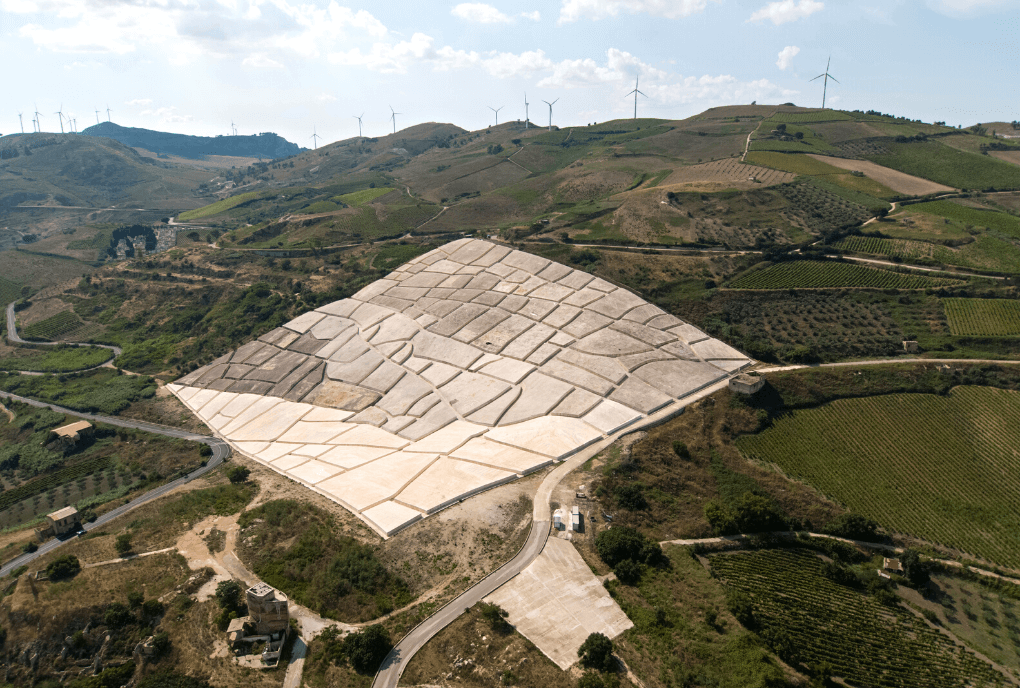
The Cretto of Gibellina: a place of dust and memories
The Cretto of Gibellina, originally named Grande Cretto, is a work of land art created by Alberto Burri. It rises where the town of Gibellina Vecchia in Sicily once stood between 1984 and 1989. It is an 80,000-square-meter expanse of white concrete and debris to tell the story of a town that has disappeared from maps.
The historic center of old Gibellina was destroyed on Jan. 15, 1968, by an earthquake, which killed 1150 people, made 98,000 homeless and destroyed 6 villages in the Belice Valley in the province of Trapani.
In the following years, the New City was rebuilt 20 kilometers from the rubble of the old settlement. Taking up the call of then-mayor Ludovico Corrao, there were many artists and architects who contributed with impetus to the reconstruction efforts. This includes Alberto Burri.
The story of a journey
The artist Burri, recounts his first visit to old Gibellina, accompanied by the architect Zanmatti, who was appointed by the mayor to take care of the artists’ side. When they found themselves at the site, the new village had been almost completed and was full of works. So Albert did not want to offer his art to the new city and they continued their journey to the debris from which he was very impressed.
The emotion of that moment emerges in his account. It was at that precise moment that he came up with the plan: since the city’s rubble was a problem for everyone, he thought of reinforcing it and with concrete turned it into an immense white crack, so that the memory of the event would remain everlasting.
What Burri’s cretto represents
In the 1970s, the artist had created a number of works using the technique of cracking, reminiscent of the cracks in clay soils. For example, the 15-meter base and 5-meter high Cretti for the Capodimonte Museums in Los Angeles. So, upon seeing the rubble of Gibellina Vecchia, Burri had the idea to make one of his cretins, this time on an environmental scale.
In 1981, Alberto covered the ruins of the Sicilian town with a kind of large concrete shroud. The white alleys that can be traversed today are similar to deep wounds in the ground, the same as the old town center before the earthquake.
The work, started in 1985 and stopped in 1989, covered about 60,000 square meters compared to the planned 80,000 with 22 blocks. Thirty years after construction began, in May 2015, the work was completed as intended by Burri, who died in February ’95.
The intent was to build a common identity, both among residents and Italians in general, through the creation of a monument of cultural and social value. A memorial that would enclose and hold within itself, in physical and metaphorical terms, the trace of the community’s past and life.
In addition, with the aim of recounting the origins of Burri’s work, its design and realization, the Museum of the Great Cretto of Gibellina was opened in May 2019, desired by the municipal administration led by Salvatore Sutera and conceived and curated by Culture Councillor Tanino Bonifacio. “The Cretto must be a place of narrative and knowledge, a place where there was life, today there is the preservation of memory,” Bonifacio declared for Artribune. The museum is located in the old Church of Santa Caterina, 300 meters away from the Cretto, and is the only surviving building from the earthquake.
Spending time through the white alleys of the open-air opera and in the narratives of the museum is like walking on a thread suspended between the present and the past. An absolute must-do experience.
Giulia Nari





